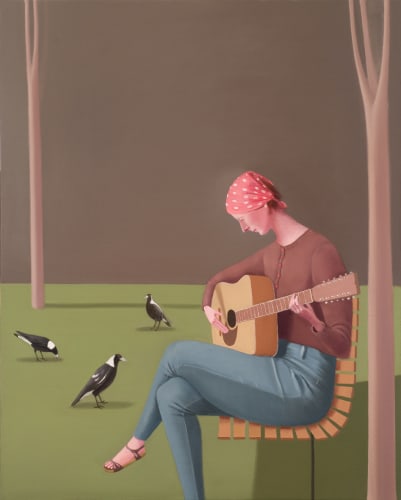Cut on the Cross
The exquisite and enigmatic portraits of 2013 Archibald Prize finalist Prudence Flint will be on show at Hobart’s Bett Gallery from 11 October until the end of the month. The exhibition, titled Cut on the Cross, centres around an intriguing series of women sewing: draping mannequins, machining seams and stitching buttons.
Flint has spent the past two decades honing a style that’s both deeply considered and uncannily cartoonish; luxuriously coloured, intimate and tender. Her quietly monumental paintings of women doing ordinary things – like reading, cooking or playing the ukulele – have previously won her accolades including the $100,000 Doug Moran Portrait Prize and the prestigious Portia Geach Memorial Award.
Flint’s Melbourne studio fronts an eight-lane highway in inner-city St Kilda, and when the traffic eases at day’s end, sewing is one of the pursuits she herself turns to. Like her paintings, sewing concerns colour and shape, Flint said. It’s textural, skilful and pleasurable.
“It’s like my sewing and knitting are very easy parts of my life – they supply a relief to other parts of my life that seem so complex and tricky and political,” she said.
“I think I really respond to the intimacy of sewing, and to one aspect of it – this incredible focus. It’s like an inversion of energy, but at the same time this lovely quiet pursuit. It’s a metaphor for painting itself.”
Flint sees the artefacts of sewing – “the needle and the button and the machine” – as curious and fascinating objects, perhaps even a little Freudian.
“When you really think about it, it’s a strange thing: you’re sitting in front of this clunky looking square object that becomes part of your body and that you use. There’s the thread and there’s a bit of a sadistic thing with the pointed needle and the potential for pricking your finger. And the insertion, that delicate insertion of the needle…”
Flint’s paintings, while not literally ‘self-portraits’, are aspects of herself, she said. Painting these focused, involved or thoughtful women entails “grappling with them”.
“I never quite know what they’re going to be like, until I understand what’s going on at some feeling level… Or I manage to get that glare in their eye and they become somebody. It will happen over time – it’s definitely a strange relationship for a while.”
“The formal problems in the painting are often quite tricky and can take a long time to resolve. I have to really just let the painting work itself out, I’ll watch it and sit and look at it and slowly solve problems as they arise.”
In recent times both home crafts and feminism have reappeared in the public consciousness, combining in the figure of former Prime Minister Julia Gillard, a self-confessed knitter in her ‘spare time’. Knitting and sewing, once domestic necessities, have gained a new symbolism. And while Flint sees sewing as in some ways an elitist craft these days – it’s no longer cheaper to make your own clothes – it’s still a private world of DIY endeavour that largely resists the pressures of contemporary life.
“I think people struggle for that now. People renovate their houses, but it all gets corralled into moneymaking… The thing about sewing is that it’s not an economic thing, it’s not a three-bedroom house. It’s never going to be an investment.”
For Flint, there’s something powerful in the quiet, private act of sewing.
“It’s very intimate. It’s very much about the moment, in the moment. You know no one’s going to die if a button falls off a jumper...”
Urszula Dawkins, 2013
-
 Prudence FlintTwelve string guitar, 2013oil on linen127 x 102cmSold
Prudence FlintTwelve string guitar, 2013oil on linen127 x 102cmSold -
 Prudence FlintSweet and Sour Soup, 2013oil on linen114 x 102cmSold
Prudence FlintSweet and Sour Soup, 2013oil on linen114 x 102cmSold -
 Prudence FlintSewing Machine, 2012oil on linen122 x 102cmSold
Prudence FlintSewing Machine, 2012oil on linen122 x 102cmSold -
 Prudence FlintQueen Anne Mirror, 2012oil on linen122 x 102cmSold
Prudence FlintQueen Anne Mirror, 2012oil on linen122 x 102cmSold -
 Prudence FlintJanette’s couch, 2013oil on linen102 x 117 cmSold
Prudence FlintJanette’s couch, 2013oil on linen102 x 117 cmSold -
 Prudence FlintDoll, 2013oil on linen122 x 102cmSold
Prudence FlintDoll, 2013oil on linen122 x 102cmSold -
 Prudence FlintCut on the cross, 2013oil on linen127 x 102cmSold
Prudence FlintCut on the cross, 2013oil on linen127 x 102cmSold -
 Prudence FlintButton, 2012oil on linen122 x 102cmSold
Prudence FlintButton, 2012oil on linen122 x 102cmSold








